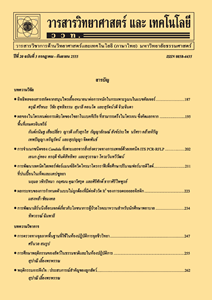การหาปริมาณสารกันบูดในก๋วยเตี๋ยวด้วยเทคนิค capillary zone electrophoresis
Main Article Content
Abstract
บทคัดย่อ
ก๋วยเตี๋ยวและอาหารประเภทเส้น มักทำมาจากแป้งข้าวเจ้าจึงเน่าเสียง่ายจากเชื้อแบคทีเรียและเชื้อรา ผู้ผลิตจึงนิยมเติม สารกันบูดลงไป ซึ่งจะมีผลเสียต่อการทำงานของตับและไตของผู้บริโภคหากได้รับสารกันบูดปริมาณมาก งานวิจัยนี้ต้องการพัฒนาเทคนิค capillary zone electrophoresis เพื่อใช้วิเคราะห์หาปริมาณสารกันบูดโดยศึกษาความยาวคลื่นของการดูดแสงที่เหมาะสมของสารกันบูด 6 ชนิด (benzoic acid, sorbic acid, methyl paraben, ethyl paraben, propyl paraben และ butyl paraben) เพื่อใช้เป็น detection wavelength รวมทั้งศึกษาสภาวะที่เหมาะสมของการแยกสารเช่น องค์ประกอบและ pH ของ background electrolyte รวมทั้ง applied voltage เพื่อให้ได้ความไวสูงสุดและใช้เวลาในการวิเคราะห์น้อย จากนั้นประยุกต์ใช้เทคนิค capillary zone electrophoresis ที่พัฒนาได้ในการหาปริมาณสารกันบูดในก๋วยเตี๋ยว
คำสำคัญ : ก๋วยเตี๋ยว; สารกันบูด; capillary electrophoresis
Abstract
Several noodles normally made from rice flour can spoil easily from bacteria and fungi. Therefore, preservatives are required and often added in noodle products. Large quantities of preservatives can affect to liver and kidney function. Thus the objectives of this research were to develop capillary zone electrophoresis technique for the determination of six preservatives (benzoic acid, sorbic acid, methyl paraben, ethyl paraben, propyl paraben and butyl paraben). The optimum absorption wavelength of each preservative was investigated and was used as the detection wavelength. The composition and pH of background electrolyte and applied voltage were optimized to obtain the highest sensitivity and short analysis time. The developed capillary zone electrophoresis was then applied to determine preservative in noodles.
Keywords: noodle; preservative; capillary electrophoresis


